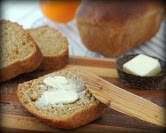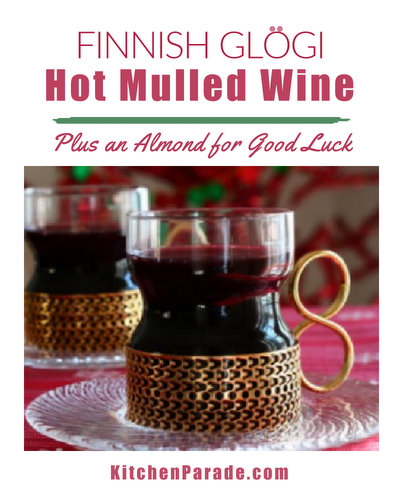| No-Knead English Muffin Bread |  |
Are you a "yeast-a-phobic" cook? A Kitchen Parade reader shares her recipe for English Muffin Bread to banish all your fears.

COMPLIMENTS!
"I absolutely love this recipe and have made it four or five times." ~ Jasmine
"I made it with half whole wheat flour and half white flour. YUM!! ... Nice texture and flavor." ~ Shannon
"... so freakin good that I plan to make this weekly. ... final product is so tender and moist." ~ Mary
"An artisan loaf at the store will run you between $3-$4, but you can make it at home for less than a dollar." ~ Budget Bytes
Crestwood reader Carole Splater has a message for what she calls "yeast-a-phobic" cooks. “It’s almost a sin that my English Muffin Bread is so easy. We love it, our guests love it, everybody loves it.”
And I love it too, ever since Carole e-mailed her recipe last fall.
No bread machine, no stand mixer, no kneading. Just a few ingredients, 15 minutes of attention and two hours later, hot delicious bread emerges from the oven. The crust is great, the crumb is perfect. If this recipe can’t resolve someone’s insecurities about yeast bread, well, their loss. Really, there is simply no need, ahem, to worry about this no-knead bread.
READER RECIPE:
ENGLISH MUFFIN BREAD
Time to table: 2 hours
Serves 8
-
(be sure to read Later Notes, below for ingredient updates)
- 1 packet yeast (2-1/4 teaspoons)
- 1 cup all-purpose flour, fluffed to aerate before measuring or 125g
- 1 tablespoon sugar
- 1/2 teaspoon table salt
- 1-1/4 cup warm (not hot) tap water
- 1-3/4 cups all-purpose flour, fluffed to aerate before measuring or 220g
- Yellow cornmeal
MIX In a large bowl, combine the yeast, 1 cup flour, sugar, salt and water. With a hand-held mixer, beat on medium speed for 3 minutes. (Time yourself, 3 minutes takes forever with such an easy job.) Add the remaining 1 3/4 cups flour and mix until fully blended. If the dough gets so thick it wants to "climb" the beaters, stop, remove the beaters, and use a wooden spoon to finish blending. The dough will be thick and heavy.
LET RISE Grease a 1-1/2 or 2-quart casserole dish and dust with cornmeal. Add dough and arrange evenly, it will be thick and heavy but don't worry, this needn’t be perfect. Sprinkle top with cornmeal. Cover with a light towel and let rise in a warm place for 30 – 60 minutes, until bread roughly doubles in size.
BAKE Some time midway, heat oven to 400F/100C. Remove the towel and bake for 30 – 45 minutes until top is golden. Turn onto a cooling rack.
LATER NOTES
CONVERTING the RECIPE to WHOLE GRAIN FLOUR Thanks to the encouragement of Shannon (a Kitchen Parade reader, see the comments below), I made the No-Knead English Muffin Bread using 1 cup freshly ground whole wheat flour and 1-3/4 cup of King Arthur's 100% white whole wheat flour. The bread was very good but a little 'earthy' for my taste. Next time, I'll try 1 cup whole wheat flour and 1-3/4 cup all-purpose flour. I'll also add a tablespoon or two of molasses to deepen the color and add a bit of sweetness that seems needed for whole-grain breads. If anyone has more ideas, I would love to know, since converting bread recipes to whole grain flours should be a definite goal for all of us.
HOW WARM IS A 'WARM PLACE' FOR BREAD DOUGH TO RISE? Like many people, I keep my house a cool 65 - 67F during the winter. Bread dough rises verrrry slowly at this temperature. So I've taken to using a small, portable space heater near the bowl. I've learned that it must be set at 75F, not 70F, for a quick rise. Good to know!
USE MORE YEAST Carole writes that she now uses a whole tablespoon of yeast to substitute for a packet. She continues, "It makes an even lighter product. I bake LOTS of bread over time and have found this to be very successful!"
THE LEGENDARY NO-KNEAD BREAD
Two years ago, the New York Times published a recipe for No-Knead Bread. Sure, the bread needed no kneading, but more than that, the technique yielded a bread with a crackling-crisp crust and a light, airy interior crumb. This would be worth kneading! Within a couple of weeks, food bloggers and bread bakers everywhere were baking loaves of No-Knead Bread. (Just check Food Blog Search, it's amazing the number of references.) I made it a few times but was unexcited, if only because it took a master clock watcher to figure out when to START the bread some time early the day before, in order to serve hot bread for supper the next night. Plus the dough was wet and sticky, hard to work with, especially for someone perhaps less confident in the kitchen. The flavor was okay, but, well, not worth the trouble. (In fact, Cooks Illustrated tested and retested the recipe, see the January 2008 issue since it's available online only with a paid subscription, and the New York Times just recently published a revision, Speedy No-Knead Bread.)
When Carole wrote to me last fall, she'd not heard about No-Knead Bread! But she'd been making her No-Knead English Muffin Bread for years, perfecting the already-simple recipe. Thank you, Carole, for letting me share your recipe with Kitchen Parade readers, I just know they'll love the ease and convenience!
DOING THE MATH ON THE COST of HOMEMADE BREAD
More Easy Bread Recipes
Celebration Breads
© Copyright 2008, 2015 Kitchen Parade










I've wondered if you could keep yeast in the freezer - that's where I keep my flour. Just remember to bring said yeast or flour up to room temperature before starting your project.
ReplyDeleteI agree with your observations on the NYTimes No-Knead Bread. Plus, I don't own a Le'Cruset dutch oven to let it rise/bake it in. (Rats.) This recipe looks interesting. However, there is no way we could eat a whole loaf in 30 minutes. And why would we want to?
Hi Sally ~ I've wondered if yeast still cold from the freezer affected rise times too, but Carole told me she just takes it out and uses it straight off. Now for flour, which there's more of and is more dense, yes, for sure, bring it to room temperature.
ReplyDeleteSeems like bakers found other vessels for baking. And I do know that Rose Levy Berenbaum adjusted the original NYT recipe for whole grain flour and a loaf sized for two.
This bread, too, is best straight out of the oven but Carole's freezing instructions work like a charm.
I've never made bread bfoere but you make it sound awfully easy.
ReplyDeleteFunny- I've been experimenting with a no-knead gluten-free bread (similar basic recipe- an offshoot of my soda breads) and the last one I made reminded me of English Muffins. And here you are with an English Muffin Bread. Maybe I'm on to something. ;)
ReplyDeleteThis is a really interesting topic for me since I rarely meet a homemade English Muffin I don't like. But what kind of flour are you referring to here? All Purpose or bread flour?
ReplyDeleteAlso I'm wondering what makes this English Muffin-like? is it the shape or the flavour or the fact that it needs to be toasted?
Thanks so much!
Karen ~ You've made my day, thank you. I think you'd find this bread easy to make, I hope it's a confidence booster!
ReplyDeleteKari ~ I'd love to be a 'taste tester'!
Shuna ~ Good question, Carole and I both use all-purpose flour. The crumb is reminiscent of an English muffin, so is the flavor, also the cornmeal on the outside contributes to the English muffin idea. Love your being here, xxo!
Luckily I'm not yeast-a-phobic, but I will try this wonderful recipe anyway. ;-)
ReplyDeleteI love your pic with the wonderful autumnal background!
Thx for your participation in WBD'08.
Just stumbled across your blog. Can't wait to try these recipes! About the english muffin bread, could it be made with whole wheat flour or whole wheat pastry flour?
ReplyDeleteErin ~ Try it with whole wheat, yes, but substitute only half (or less) to start out. I'd love to know how it turns out, since I've only followed Carole's recipe myself.
ReplyDeleteI absolutely love this recipe and have made it four or five times.
ReplyDeleteThanks so much for your site, I really appreciate it. And I love that you have the WW points as well. I am 5 lbs from goal and having lots of tasty recipes helps me to stay on course.
I'm a little confused on the recipe- it has flour listed twice. Is the larger amount correct or am I missing something?
ReplyDeleteI list the amounts separately because they're added at different times. Hope this helps!
ReplyDeleteSo, I made the bread with whole wheat flour and accidently used WAAAAAY more than I intended. My intention was half whole wheat and half white. I got distracted and used 2 1/4 cups whole wheat and 1/2 cup white. The bread was dense (no nooks and crannies like when I made it with all white flour) and a tad doughy in the very middle, but the flavor was quite good. I'll definitely try it again using only half whole wheat and half white flour. Then again, I wasn't at all bothered the denseness, so I may just try it with all whole wheat. What a wonderful and easy recipe!
ReplyDeleteOkay, attempt #3. I made it with half whole wheat flour and half white flour. YUM!! Denser than with all white flour, not as dense as with all whole wheat flour. Nice texture and flavor.
ReplyDeleteShannon ~ Thanks so much for reporting back. With all of us working to incorporate whole grains into our diets, it's so good that an everyday bread that's so easy can be of help!
ReplyDeleteHello- I looooooove the English Muffin bread. I would love to get the same results with individual English Muffins. Do you think they would turn out? I have rings but was curious what you thought. I was thinking of trying to pout them on a heated flat top- couldn't figures out a way unless I pout them on parchment & cook on parchment on the flat top? just curious of you've tried to make individual muffins with the recipe?
ReplyDeletethanks!
Margieorsestr
Margie ~ You know, it might work. But if it were me, I'd check out recipes especially designed for making individual muffins, rather than a loaf.
ReplyDeletewow! this is such an amazing Blog - not only are there great vegetarian recipes( sadly some contain eggs, which is not really vegetarian, but am not cribbing) and good pictures, but Alanna replies to each post / comment / question! thank you for this Blog and your generosity, Allana! Bless you.
ReplyDeletethis becomes 4 points plus
ReplyDeleteI made this bread over the weekend and it was so freakin good that I plan to make this weekly. It's quick, easy and the final product is so tender and moist. Great with stew or soup or toasted in the morning with coffee.
ReplyDeleteWhat kind of bread tins would you use for this instead of the casserole dishes? Thank you.
ReplyDeleteCatherine ~ Y'know, I'm not sure if the ceramic / glass casserole-type dish is important or not - like the old tale about the woman who always cut off the end of her roast and didn't think about it until someone asked and she realized she had picked up the technique from her mother - who had a small roasting pan!
ReplyDelete